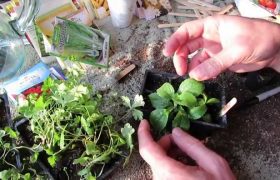Stevia rebaudiana is an extremely sweet-tasting plant native to Paraguay. It is 10 – 20 times sweeter than sugar, so only a tiny amount of leaf is required for recipes. However, its popularity has been limited due to the small number of seeds available on the market. Additionally, stevia plants are difficult to germinate (grow from seed). This article will discuss how to germinate stevia seeds.
How to germinate stevia seeds?
- Place seeds between a couple of wet paper towels and put them in a dark place for 24 hours.
- Transfer the stevia seeds to a small pot filled with peat, perlite, or vermiculite, avoiding damage to the seed coat. Be sure the pot is well-drained. The surface of the soil must remain moist at all times.
- Place the pot in a sunny location where temperatures stay between 65 and 75 degrees Fahrenheit (18 and 24 degrees Celsius). Keep the soil moist and wait for germination to occur, which should take approximately one week.
- Transplant the seedlings when they have developed their first set of leaves into small pots filled with potting soil.
- Keep the plants in partial sunlight and move them to a shaded area when they are moved outside for summer or winter, depending on your climate zone.
How long does it take for stevia to germinate?
Seeds usually germinate within one week. The easiest way to raise stevia plants is by starting with seedlings. This eliminates the need for pollination, but it does require patience because seeds can be difficult to locate. Additionally, young plants do not produce as much leaf as mature plants.
It is difficult to grow stevia from seed, not only because of the low availability of seeds but also due to its complicated pollination process. Stevia plants are self-sterile and need to be cross-pollinated for fruit and seeds to develop. Follow the steps mentioned above.
Start a stevia farm
Select a location where stevia plants will grow and thrive and be free from strong winds and frost. Clear the land by removing all stones, weeds, and other unwanted materials that would interfere with the healthy growth of the plant.
Prepare the soil by turning it over to a depth of 8 inches (20 cm) and adding organic compost, manure, or other fertilizers to improve the soil structure. Install irrigation lines that are appropriate for your climate zone and area, but do not cause waterlogging of the soil. If you live in an arid (dry) region with low rainfall, collect water through a well dug near the farm site.
Plant stevia seeds in spaces created between other crops such as corn, beans, and other fast-growing plants. Protect the plants from weeds and animals by installing fences or other protective barriers.
Harvest leaves after 9 – 10 months and dries them under the sun until they turn brown and crisp. The best tasting dried leaves are those that have been thoroughly dried with strong sunlight.
Stevia leaf is an ideal substitute for sugar due to its extreme sweetness. It can be used in beverages, desserts, baked goods, and many other recipes. The plant only requires partial sunshine and moist soil with loose texture. You can germinate stevia seeds by following the steps. You may also like to read this article germinating seeds in paper towel in House I love.



